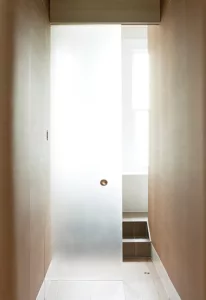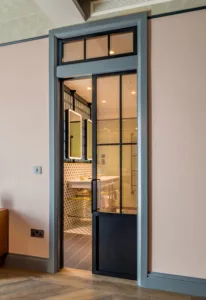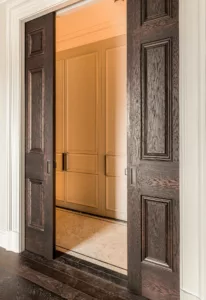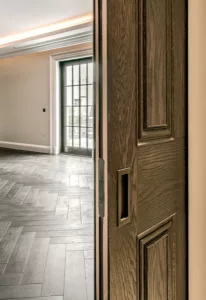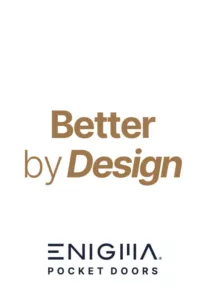Shifting the paradigm of Pocket Doors

Harry Purdom joins Laura Elliot (Director of Ron Blank and Associates, Inc), on her podcast as guest to share his passion about bringing the value of pocket doors to every building project in America. Keep a look out America, Enigma pocket doors are coming!

Who are Enigma?
Enigma was founded to simplify the pocket door market by solving the common problems with pocket doors but also innovate and open new opportunities. This fits into our why.
Traditionally used for bathroom doors to save space for a shower, or to save space in a utility room for a washing machine or dryer. However, Enigma wanted to shift the paradigm relating to pocket doors, then the possibilities are endless and can be used in so many more applications.
In the past few years, pocket doors dipped in popularity due to bad experience but now due to improved technology, the popularity is increasing. We have seen this with our Motus Pocket Door which is a power assisted, innovative electric sliding door system features a contactless electromagnetic propulsion mechanism, ensuring quiet operation and reducing the need for user intervention.
How can simplifying the process from creation to installation benefit the end user?
Pocket doors are being simplified to help the end user, right from the initial design. A pocket door is slightly different to a swing door, where the door and frame can be installed into the opening. With pocket doors, there is a dual element so it is slightly different, as you have the integration with the dry wall as well as the door itself, which needs to be considered as part of the design and specification point of view so the integration is done correct and the finish.
The installation sequencing is very important. The installation of the pocket before the dry wall can be completed and the installation of the door before the whole thing can be finished, decorated and completed.
There are three main aspects when looking at a pocket door system that can make a difference to the success of the pocket door:
1. Pocket or the gauge system – where the door slides into and where the dry wall gets fixed too and if it’s not done correctly it can cause issues with the side walls not being sturdy enough which can lead to warping or scraping against the door or even jamming the door. The materials of that become really important then.
2. The running gear – an unseen part of the pocket door but this is really important from a longevity and durability perspective. If you get this right then the smooth running and the ability to take the weight of the door for a long period of time, even if it is sitting in the same position, will still run smoothly. It’s also important to keep as much dirt and dust out of the running track as possible, so proper installation and a well-designed running track are essential.
3. The finishing – you can have the most functional pocket door in the world but if it looks terrible then it’s no good. Things to consider are the design of the trims, can integrate into the existing design of the property and is it integrating into the wall so it doesn’t look like it part of the existing interior design.
What are the standout features of these new pocket doors?
A major factor why contractors choose pocket doors is saving space. If you think of how many rooms are in a hotel or apartment block, if you installed pocket doors instead of swing doors, you could potentially save enough space to have another apartment or hotel room. This is where you see a large return on investment.
We want the design to be as easy for the installer to understand, as this will mean correct and gaster installations. The modular concept is a great example of this.
The integration into the wall is another, as well as the guide aspect (the way the door slides) as this makes a huge difference to the experience of the pocket door. The guide technology are much better than previously which makes it less likely to rumble and more durable.
What materials make up the system?
One of the most positive changes for the materials used in pocket doors has been the use of aluminium. This is because it is lightweight but is still strong and a better alternative to timber slats which can warp.
The materials for the running gear have also improved, particularly the wheels themselves, which are now durable enough to stand the test of time and can carry more weight. Pocket doors often sit in one place for a long period of time, which creates a flat on the bottom of the wheel and can sound like a train track when it is then moved! The new running gear material is much more durable.
Breaking down the difference between a bushing, ball bearing and needle bearing for pocket doors.
Where ball bearings are used, for the oscillating movement means that the balls can shift in position because they are not complete in the channel around the wheel. This can caused an uneven weighting on the axel, which can create a weakness in that ball bearing and lead to cracking or breaking the wheel, especially if the door is slammed.
The needle bearing really solves these issues as it holds the lubricant in, which means it lasts an incredible amount of time, and they are really small cylinders all around the axel. This provides an even weighting around the axel and coupled with the lubrication, makes a huge difference to the performance and longevity of the pocket door.
What is the huge potential for optimizing space in modern buildings?
Pocket doors are traditionally used for bathroom doors and utility doors, however pocket doors can be used for every internal scenario in a home or hotel. Pocket doors not only save space but create space as well. If an interior is designed with pocket doors in mind, then so much more space can be created.
An architect we work with managed to fit 50% more people in their office, without increasing their office space, due to designing with pocket doors in mind.
Why are pocket doors not more widely used?
Past user experience has definitely impacted pocket doors not being used more frequently, which comes down to poor hardware. Design and hardware has improved so much that this won’t be an issue if the pocket door has been installed properly.
Can you discuss the importance of proper installation and maintenance for pocket doors?
If the installation is done correctly and the hardware is good quality, then ideally maintenance shouldn’t be required. If you procure a pocket door that is designed to last the test of time, is designed to fit into the wall and is installed properly, then maintenance shouldn’t be required.
What are some common flaws found in other pocket door systems?
One of the most common issues is flimsy side walls. This is where when they create the pocket or they cage to slide into, if that easily moves or warps, then when the frame is fixed to the dry wall, and that fixes the pocket door in place sliding into a bowed wall which can lead to scraping on the door.
Lack of finishing options can also make the pocket door look like a design after thought, which again adds to the negative user experience. Also, bad quality running gear, which is not durable and can lead to a rumbling pocket door.
How does the use of aluminium for the cage system benefit the installation process and overall durability?
Aluminium is a great material as it is easy to use and cut on site, but it is also a strong material. When creating a pocket, you must fit a door and the tolerance within the width of the stud, which could be 4 inches. You have minimum space to create maximum strength. Aluminium makes this process more simple, easier and gives adaptability.
What is the significance of the needle bearing in the running gear and how that impacts performance?
The needle bearing provides equal and consistent loading, which when the door is moving backward and forwards or sitting in one space for a period of time, will increase the longevity of the pocket door. This is because ball bearings do not have equal loading and can wear down and create a flat, which causes rumbling and a poor user experience.
With the Enigma Pocket Door system, we tested to 100,000 open/close cycles and then left for a couple of weeks in one position and then retested, all whilst under 300lbs of load.
What are the customization options for pocket doors, such as door size, frame visibility and handle types?
Because pocket doors are integrated into a wall system and often with swing doors, it is important for them to fit in with the rest of the interior design. At Enigma, we provide a range of finish options, which isn’t common with pocket door manufacturers. We provide the finishing trims for installers both visible and concealed.
How can pocket doors be tailored to various architectural and design needs?
It depends on the design, whether it is very sleek and minimal or grander with a lot of features. We provide flexibility in sizes and tolerance when fitting, a range of different trim and finish options, so the pocket doors help create a beautiful contemporary interior for your project.
The other option is custom joinery integration for cases where there is wall panelling, to help create a perceived hidden door.
What are the differences between concealed and visible frame and how can they each be used?
It will depend on the type of design between traditional or modern and how it fits with the swing doors in the apartment. At Enigma, we want to provide options to create the best user experience possible.
How are pocket doors being received in the US market?
The feedback has been really good, we have made some adaptions to suit the US market but how our Enigma Pocket Doors can solve common pain points, US architects and contractors have received our pocket doors really well.
How do you see the market for pocket doors evolving in the US, particularly in residential and hospitality sectors?
The residential and hospitality sectors will be the two sectors which will pivot from the previous negative connotations with pocket doors and will benefit from the new technology which provides a great user experience. Pocket doors will begin to be used outside of just bathroom and utility rooms and in other internal rooms as well as commercial and ADA. Enigma has power assisted pocket doors which provide a great user experience for ADA, to automatically open a door and the door doesn’t swing inwards towards the user.
The other aspect is acoustics, with acoustic rated pocket doors becoming popular in offices for meeting rooms, where a sound reduction is needed. There are an increasing number of applications where pocket doors can be used.
What are the innovative products or features that meet market needs?
Alongside the improved hardware, which has increased the longevity, durability and user experience of pocket doors, the soft-close/open feature has been popular. This helps increase the longevity of the door but also provides a nice user experience, particularly in hotels or apartments, where slamming doors can be annoying to other residents or guests.


